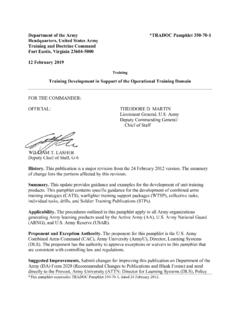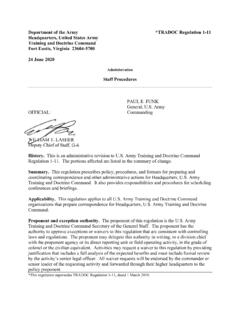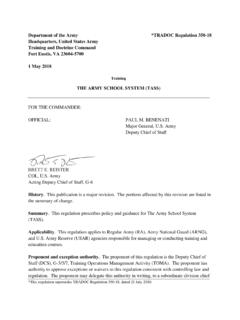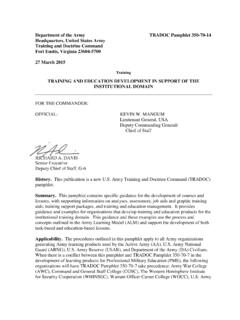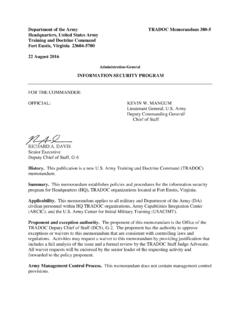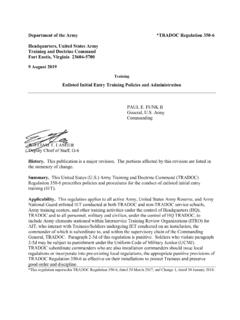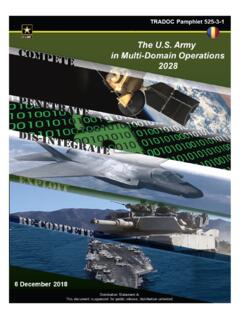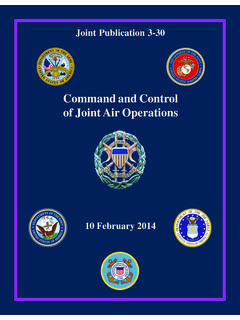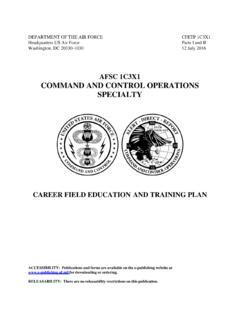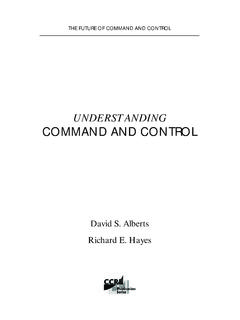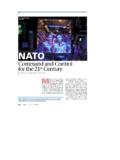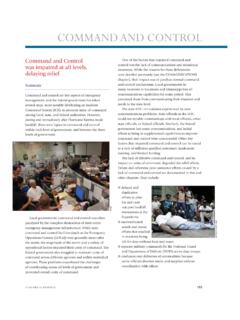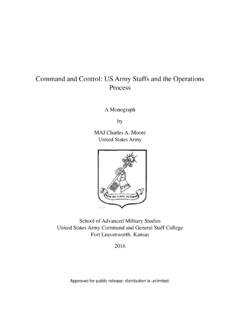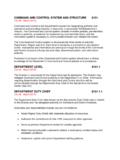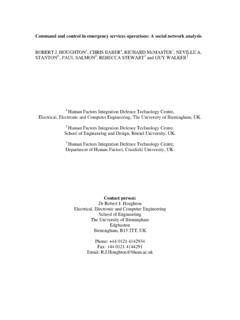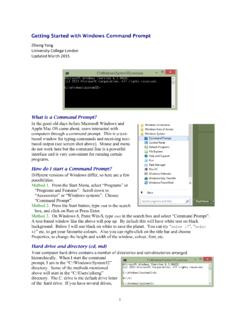Transcription of Airspace Command and Control - adminpubs.tradoc.army.mil
1 TRADOC Pam 525-7-3 1 TRADOC Pamphlet 525-7-3 The United States Army Concept Capability Plan for Airspace Command and Control for the Future Modular Force 2015-2024 Version 20 April 2009 TRADOC Pam 525-7-3 2 Page intentionally left blank. TRADOC Pam 525-7-3 i Foreword From the Director Army Capabilities Integration Center Airspace Command and Control (AC2) as defined in TRADOC Pamphlet (Pam) 525-7-3 replaces Army Airspace Command and Control (A2C2) which was primarily a planning and integration process. AC2 is the dynamic integration of all Airspace users in accordance with the commander s intent, priorities, and risk guidance. While not unique to Airspace , jointness, priority to supported commander and speed of events affect AC2 more than other C2 tasks.
2 TRADOC Pam 525-7-3 is fully nested within joint and Army concepts and integrates the Airspace requirements necessary to support the Army s family of capstone, operating and functional concepts. AC2 has become a complex challenge for commanders that can no longer be addressed with simple preplanned routes, fixed altitudes, and static Control measures. The current plan-centric method of controlling Airspace use does not enable commanders to fully integrate all Airspace users with ongoing operations in near real time. While detailed planning will remain critical, AC2 will shift from a planning to an execution centric activity enabling individual Airspace users to be retasked dynamically to respond to immediate needs. The focus of Airspace management will change from today s practice of reserving large blocks of Airspace for potential use to protecting Airspace near Airspace users.
3 Automated decisionmaking will use relevant information from sensors and self reporting platforms to integrate Airspace users in accordance with commander s priorities and risk levels automatically. The operational environment during the 2015-2024 timeframe will increase in complexity with the proliferation of unmanned aerial systems and the introduction of host nation, nongovernmental agencies, and civil aviation to the battlefield. This presents commanders with Airspace challenges not previously encountered. In order to successfully operate in this OE, future Modular Force commanders at all echelons must be capable of synchronizing forces and warfighting functions in all four dimensions in near real time. TRADOC Pam 525-7-3 ii Page intentionally left blank.
4 TRADOC Pam 525-7-3 iii Executive Summary Introduction Future Modular Force commanders at all echelons must be capable of synchronizing forces and warfighting functions in the vertical dimension in near real time. AC2 is the dynamic integration of all Airspace users in accordance with the commander s intent, priorities, and risk guidance. The primary A2C2 deconfliction method was to reserve Airspace for each Airspace user and then ensure that each Airspace user stayed within their reserved Airspace . A2C2 was not responsive enough to dynamically support current operations forcing commanders to accept excessive risk to Airspace users, to operations or to both. Often, the Airspace requested was no longer needed by the time it was approved, disseminated, and activated.
5 While A2C2 was effective for managing Airspace use for the legacy force, it is incapable of meeting the requirements of the future Modular Force. Purpose The purpose of TRADOC Pam 525-7-3 is to describe how future Modular Force commanders will conduct AC2 and to identify the capabilities required to implement AC2 fully. The description of these capabilities will be sufficient to enable follow-on analysis designed to develop doctrine, organization, training, materiel, leadership and education, personnel, and facilities changes required to integrate AC2 into the future Modular Force Command and Control (C2) warfighting function. The capabilities identified in this document will enable the effective integration of AC2 into the C2 warfighting function of the future Modular Force and synchronize these with joint battle management.
6 This will provide future Modular Force commanders the same flexibility and responsiveness for Airspace and Airspace users as for ground area of operations and maneuver forces. Scope The capabilities described by this plan are applicable to all Army echelons with responsibilities for C2 of Airspace and Airspace users, from tactical to operational level, through all operational phases, focused on the timeframe of 2015 2024. Typically, this includes combined arms headquarters from brigade combat team multifunctional brigades through theater Army headquarters. However, based on mission, enemy, terrain and weather, troops and support available, time available, civil consideration and task organization, some of the capabilities will be applicable to platform and platform controller level, such as situational awareness and data and voice beyond line of sight and non line of sight communications.
7 Military Problem AC2 has become a complex challenge for commanders that can no longer be addressed with simple pre-planned routes, fixed altitudes, and static Control measures. The current plan-centric method of controlling Airspace use does not enable commanders to integrate fully all Airspace users with ongoing operations in near real time. The increasingly complex operating environment with the proliferation of unmanned aircraft systems and the introduction of host nation, nongovernmental agencies, and civil aviation to the battlefield presents commanders with an Airspace challenge not previously encountered. To successfully operate in this environment, future Modular Force commanders at all echelons must be capable of synchronizing forces and warfighting functions in the vertical dimension in near real time.
8 TRADOC Pam 525-7-3 iv Solution Synopsis and Key Ideas The Army will improve Airspace access and safely and effectively increase the density of Airspace users by building Airspace Control nodes into combined arms headquarters optimized to Control Airspace in tactical areas from low to mid altitudes. These AC2 nodes do not replace or supplant existing Airspace C2 elements provided by other Services. Rather the Army provides the joint force commander s theater air ground system additional C2 assets. TRADOC Pam 525-7-3 incorporates the following key ideas. AC2 is both a major task within the joint and Army C2 warfighting function and a major activity of the joint interdependency category of joint battle management. The Army will contribute to the joint force commander s Airspace Control system by enabling combined arms headquarters to Control joint Airspace over an Army area of operations.
9 While detailed planning will remain critical, AC2 will shift from a planning to an execution centric activity enabling individual Airspace users to retask dynamically to respond to immediate needs. Networked sensor data coupled with self-reporting data from Airspace users will enable the situational awareness necessary to integrate Airspace utilization with commander s priorities. Automated decisionmaking will use relevant information from sensors and self-reporting platforms to integrate Airspace users in accordance with commander s priorities and risk levels automatically. Networked infrastructure and interoperable data will connect decisionmakers at joint C2 nodes in near real time enabling collaboration during the operations process. Airspace Control elements will have beyond line of sight and non line of sight data and voice communications in all required frequency spectrums with all Airspace users (joint, Army, multinational, governmental, and civil).
10 This capability will exist at the platform level and will allow all Airspace users to see the relevant portion of the common operational picture in near real time enabling immediate hazard avoidance at the platform level as combatants react to battlefield action. TRADOC Pam 525-7-3 is fully nested within joint and Army concepts and integrates the Airspace requirements necessary to support the Army s family of capstone, operating, and functional concepts. TRADOC Pam 525-7-3 1 Department of the Army TRADOC Pamphlet 525-7-3 Headquarters, United States Army Training Doctrine Command Fort Monroe, Virginia 23651-1046 20 April 2009 Military Operations THE ARMY CONCEPT CAPABILITY PLAN FOR Airspace Command AND Control CONCEPT CAPABILITY PLAN FOR THE FUTURE MODULAR FORCE 2015-2024 FOR THE COMMANDER: OFFICIAL: DAVID P.
